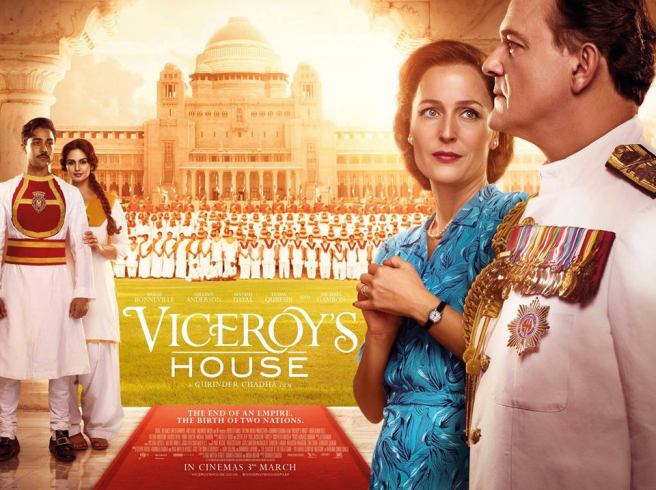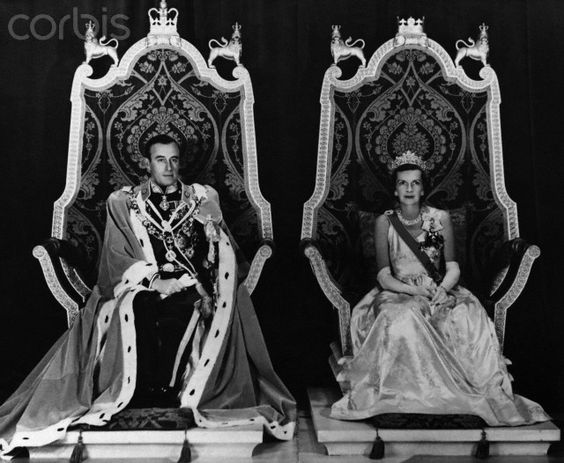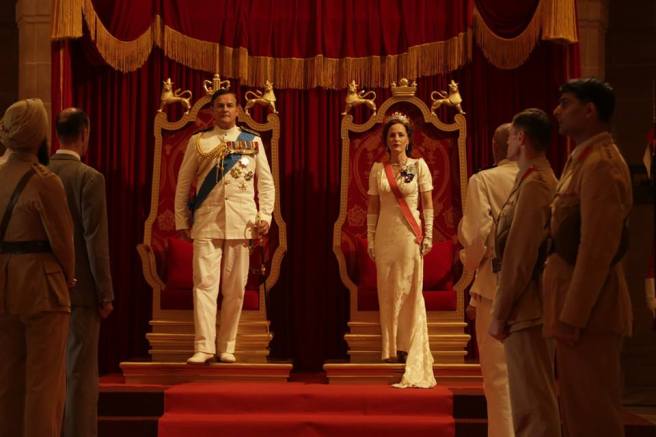Bloggers’ Note: Although this film falls beyond our time frame, we felt this warranted a review as the Mountbattens were regular fixtures in British newspapers from their wedding in 1922 until their deaths in 1960 and 1979 respectively.
With 2017 marking the 70th anniversary of Indian independence (and the creation of Pakistan as well), the release of Viceroy’s House is perfectly timed, a narration of the road to Indian independence and the birth of two nations. Directed by Gurinder Chadha( best known for Bend it like Beckham), she has partly drawn from her family history for this film. But most of the action is set in the magnificent Edwin Lutyens-designed viceregal palace (now the residence of the President of India) with its massive rooms and grounds which in the words of Edwina Mountbatten in the film, “makes Buckingham Palace look like a bungalow.”
There’s a mention of her grandmother’s experience of being displaced as the boundaries between the two new nations were drawn so it makes me wish that she had brought her grandmother’s story to the big screen as a representative of what happened to millions of families. Instead what we get is a potted history lesson mixed with an upstairs-downstairs narrative that’s pretty much lifted from Downton Abbey. I will go further by saying that Viceroy’s House is a direct photocopy of Downton Abbey.

The year is 1947 and Britain exhausted by the Second World War is preparing to transfer power in India for 1948. Overseeing this is the new viceroy; Louis (“Dickie”) Viscount Mountbatten of Burma (Hugh Bonneville) accompanied by his wife Edwina (Gillian Anderson) and their younger daughter Pamela (Lily Travers). At the same time, former policeman Jeet Kumar (Manish Dyal) arrives at the palatial viceregal palace to begin his new job as a valet to the new viceroy where he encounters a secretary, Aalia Noor, (Huma Qureshi), who he recognises as the daughter of one of the political prisoners he helped guard. Predictably the two fall in love but Aalia is already promised to another man and as her father reminds her, to marry him is honouring her dying mother’s wish.
Meanwhile Mountbatten is faced with a dilemma, should India remain as one nation or two with India as a Hindu majority (together with the Sikhs) state and Pakistan which would be a Muslim majority country? While he tries to reach a settlement between Jawaharlal Nehru (Tanveer Ghani) and Mohammed Ali Jinnah (Denzil Smith), violence flares across India and in the end, its accepted that partition and bringing the date forward for independence will help ease the violence. A senior judge, Sir Cyril Radcliffe (Simon Callow) is brought into India to determine the borders between the two countries. With a very limited timeframe to do his job, and with the added disadvantage of never having been to India before, Sir Cyril struggles, especially as there are areas where the split between the two faiths is even. He confides this to General Hastings Ismay (Michael Gambon), and he is shown a plan from 1945 that already showed the borders between India and Pakistan. When Mountbatten learns about this, he is shocked to learn that Churchill had authorised this to safeguard supplies of oil and to create a buffer against the Soviets.
Despite this, partition goes ahead and as a result, two nations are born while there is a massive movement of peoples between the two new countries. And what of Jeet and Aalia? Well, there is a sort of happy if slightly implausible ending in the manner of all soap operas. Actually, if I’m going to be honest, it was a jaw-dropping “wait, what? You are using THIS as a dramatic device??” moment, but possibly that’s just me.
As mentioned earlier, watching Viceroy’s House led to me to the conclusion it was a photocopy of Downton Abbey not only with the opening sequence and the upstairs downstairs drama but even with the casting of Hugh Bonneville as Mountbatten. This must have been the worst piece of casting since Dick van Dyke as Bert in Mary Poppins or Sean Connery as Captain Marko Ramius in The Hunt for Red October; Bonneville with his beefy frame is nothing like the lean Mountbatten. Neither does he have the real Mountbatten’s clipped tones, effortless charm and breezy self-assurance. Instead what we see is a man out of his depth, weak and hesitant – much like his Downton Abbey character Lord Grantham. The director doesn’t help this obvious miscasting by ending the film with newsreels of the real life Mountbatten as Viceroy – the contrast is glaring.


If Bonneville reprises Robert then Gillian Anderson is Cora (and interestingly was reportedly offered the role before Elizabeth McGovern). She’s convincing as Edwina Mountbatten but her attempts at affecting a cut glass accent sometimes descend into parody. In addition she’s not really given much to do apart from constantly remind her husband of why they’re in India (hello, he’s the last Viceroy entrusted with the task of giving India its independence, I think he might know already), and act as a human United Nations statistics booklet (“Darling do you know that 92 per cent of the population are illiterate?”) in a script that very often recalls Downton Abbey at its expositional finest. And for a film that focuses a lot on real life characters, there is little done to flesh them out as people – who they really are and how their behaviours could have help affect the course of history. Nothing is made of the Mountbattens’ married life especially as they had been living virtually separate lives since the beginning of their marriage or the purported affair between Edwina and Nehru. Even Jinnah’s illness was not mentioned much less alluded to. There’s very little depth of character and sometimes it feels like the script is a taken from school textbook about independence – kept to the basics and shorn of the complexities. A feeling not helped by the almost insultingly brief running time – 106 minutes to explain a process that cost a couple of million lives. (Perhaps that should be “attempt to explain independence.”)
Ironically it’s the servants who are given the better storylines and scenes. They operate as a huge and well-organised team to serve the Mountbattens and while they are doing that they listen to the radio, read the papers and catch snippets of meetings. While they discuss and argue, the cracks between Muslim and Hindu start to show, especially when they have to decide what country they are going to go to after independence. A striking example was the two chefs and the look of anguish on the head chef’s face when he hears his deputy had chosen to become Pakistani is a microcosm of how politics has infiltrated a workplace where people have worked alongside together for years if not decades and have now been torn apart. Gradually we see the cracks widen between Hindu, Sikh and Moslem and degenerate into physical violence in an echo of what is happening outside the residence’s gates. There are also very poignant human touches that bring home the innumerable tiny human tragedies – Jeet’s colleague comes back from their village, where he has found their families dead or missing, but carrying a baby girl, the sole survivor of a massacre. A Hindu woman has picked up a Moslem girl who has escaped the killing of everyone on her train and wants to adopt her, and gets very angry with the official insistence that this is a queue for Hindus, the badly injured girl must go elsewhere. Little touches of humanity in the face of overwhelming disaster.
While Jeet and Aalia’s love story is pretty much standard soap opera fare, individually both characters have potential and yet are undeveloped. Jeet himself has an interesting background – a policeman who spent most of his career arresting and guarding pro-independence activists but whose father was killed by the British: but that’s never explored, and neither is the reason why he has given up his job as a policeman to be a viceregal servant in the dying weeks of the Raj. And what about Aalia? We don’t know much about what she thinks and feels as an individual: the tension between her clearly Westernised education and outlook as opposed to the traditional family demands being made on her is clear but ignored. What’s also omitted is the upper staff who are mainly British save for the major domo who is clearly Indian but is very Westernised, what’s going to happen to them? The major domo has a close working relationship with his immediate superior, the comptroller of the household (who is British) and yet what will happen to both men is a mystery, when actually that would have made a better storyline than what we’ve seen on screen.
Viceroy’s House major weakness however (and again this is where the similarity to Downton Abbey is in the distortion and trivialising of great events) is how the film glosses over Mountbatten’s incompetence and the intransigence of the Indian side. Instead blame is placed on Winston Churchill despite the fact that in 1947 he had been out of power for two years and was in no position to influence events (in fact he did vote in favour of the Indian Independence Bill and urged his party to do the same). This weakness is made worse by historical inaccuracies such as the view that Indians were not ready to govern themselves when in reality they were already native Indians serving as mayors and councillors as elected by their fellow Indians and by the 1930s the Indians were already outnumbering the British in the Indian Civil Service (ICS). The constant bleating about “divide and rule” was also grating and conveniently forgets that “divide and rule” tactics were already used in India long before the British came.
The dialogue is heavily expositional and the narrative is simplistic, it’s all “Oh Jinnah wants Pakistan, what shall we do?” “Look, here’s a plan all handily drawn up in 1945 by Churchill with the borders neatly drawn in but don’t tell Mountbatten. That’ll sort it.” Independence and partition is wrapped up in about 10 minutes with contemporary newreels of massacres, long trails of miserable refugees and the Mountbattens and Nehru looking anguished over what has been unleashed.
The plus side is the visuals. If there’s one thing that this film does really well, it’s capturing the vibrant real-life locations of both the Viceroy of India’s residence and the streets of India. Filmed entirely on location, the grandeur of the main stage is fantastic to look at, whilst the costume design ranges from Mountbatten’s decorated military attire to the colourful uniforms and dress of the Indian servants.
Unfortunately for the success of the film I left the cinema feeling manipulated and that an agenda was at play. The film ends with the information that the director’s family fled the partition, that on the way her grandmother’s baby died of starvation and it was after nearly two years in a refugee camp that her grandparents were re-united. I’m not in the slightest downplaying this dreadful human tragedy, but it was one of millions, and it’s being used to peddle an essentially very selective view of the history that comes from two books – Freedom at Midnight, whose authors had access to the Mountbatten archives and the man himself and veers close to hagiography at some points and The Shadow of the Great Game: The Untold Story of India’s Partition by a former Indian diplomat, Narendra Singh Sarila, who was a junior member of Mountbatten’s staff and who maintains that Churchill was the culprit for the bloodshed of partition.
As Ian Jack points out in a scathing Guardian review, historians have given this short shrift, but the power of film is such that there are going to be millions who take away from this the message that Mountbatten and Nehru were guiltless and that Churchill and Jinnah were the evil geniuses of partition. As Jack points out
Chadha denied the charge of anti-Muslim prejudice – persuasively, I think – but to my mind she and her fellow writers on the film, her American husband, Paul Mayeda Berges, and the English screenwriter Moira Buffini, have committed just as great a sin, which is to take a breathtaking liberty with the historical record.
As he goes on to say The film is unlikely to do very well at the box office. Even so, it will attract a far larger audience than any book on partition, and for many people it will be their only understanding of the subject. As with “fake news”, so with “fake history”. Detecting it needs curiosity – critical rather than passive consumption – otherwise it never gets found out.
And that’s the danger of this film, because film is a much more powerful medium than the written word and misrepresentation can be taken away as gospel truth (as demonstrated by more than enough viewers who think that Downton Abbey accurately represents early 20th century Britain). If people want to learn more about independence and partition, Viceroy’s House isn’t the film I would recommend. Viewers are advised to purchase, rent or borrow DVDs of Richard Attenborough’s film Gandhi (1982) and The Jewel in the Crown (1984), a 14 part drama produced by ITV. Both explore the complexities of Indian society and politics in the dying days of the Raj and the road to independence in a sensitive and historically accurate way that Viceroy’s House has failed to do.
Further Reading:
http://www.forgotten-raj.org/doc/viceroy.htm
http://www.dailymail.co.uk/news/article-4302730/Viceroy-s-House-whitewashes-Lord-Mountbatten.html
Andrew Roberts. Eminent Churchillians (London, 1994)
Alex von Tunzelmann. Indian Summer: The Secret History of the End of an Empire (London, 2008)
Stanley Wolpert. Nehru: A Tryst with Destiny (Oxford, 1996)

When I saw this advertised, I said to my wife, “Downton Abbey in the sunshine”. It seems from reading your excellent review that I was on the right lines. All the ‘usual suspects’ are rolled out (Gambon, Callow, etc) and the scene is set for something cosy and familiar to TV viewers.
My father served in the army in India for most of the war, and had to stay on for the partition riots, and the extensive peace-keeping role required. He told me a great deal about the violence and double-dealing that went on at the time. So like you, I worry about ‘false history’.
I second your endorsement of ‘Jewel In The Crown’ too. A landmark series that approached the subject in depth.
Best wishes, Pete.
LikeLiked by 2 people
Your welcome and I won’t be surprised that your father had vivid memories of his time there. Under the review, I’ve linked a blog from an Indian writer who does rebut the film in greater detail than I could have had.
LikeLiked by 2 people
The Jewel in the Crown was superb. If you haven’t yet read the Paul Scot books on which it was based, you have a treat in store.
LikeLiked by 2 people
I did read them at the time, Sarah, and agree that they were even better than the TV series. x
LikeLiked by 2 people